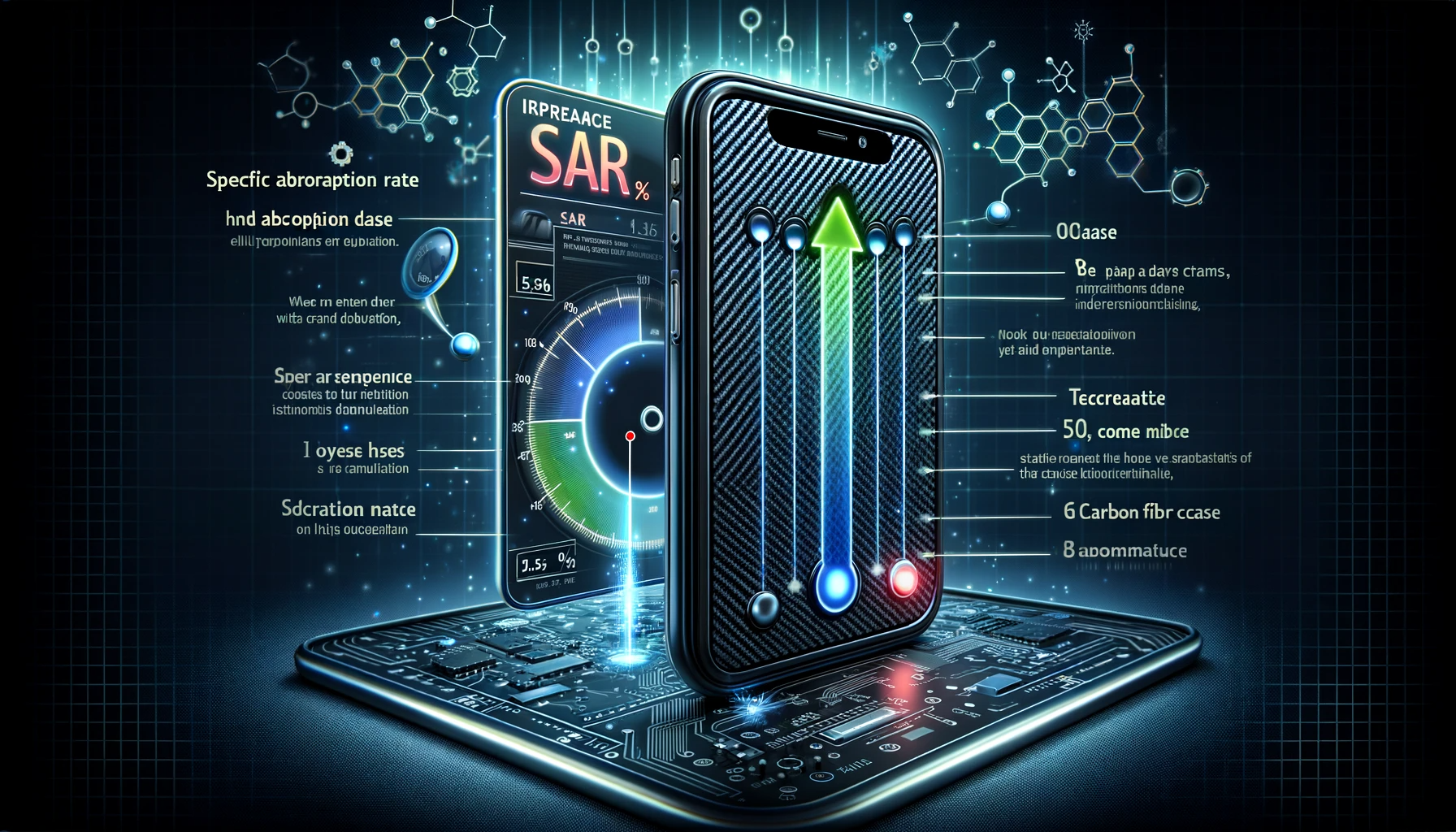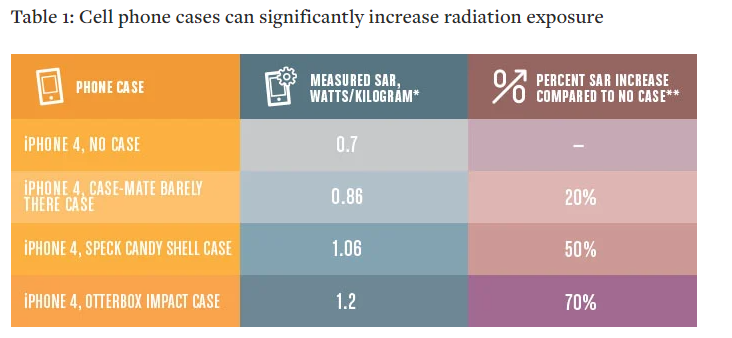This answers the question of why QuantaCase is so thin! Here is the data to support the reasoning.
Alarmingly, certain brands of very popular cell phone cases, including those made from high-impact materials like carbon fiber, can raise a phone’s SAR by up to 70%. These materials, while offering physical protection, can inadvertently boost the phone’s radiation output by interfering with antenna functionality.
The design and material of a cell phone case significantly impact radiation exposure. Cases with metallic parts, like loops for carrying straps and detachable magnetic inserts, can alter the phone’s radiation properties.
But what about extra heavy-duty rugged cases? For example, as shown below, tests on different types of cases, such as the Otterbox Impact, Case-Mate Barely There, and Speck Candy Shell, have all shown varying degrees of SAR increase. Despite their lack of metallic parts, these cases still heightened the user’s radiation exposure. The Federal Communications Commission (FCC) has not updated its guidelines to reflect the impact of phone cases, leaving a gap in consumer safety standards so this should be a concern for all cell phone users.
Introduction
In an era where smartphone usage is ubiquitous, concerns about radiation exposure from these devices have prompted many users to turn to protective cases. However, not all cases are created equal. Recent studies and innovations in case design, like the RF Safe QuantaCase, highlight the importance of choosing the right type of case to minimize radiation exposure.
The Problem with Poorly Engineered Cases
Specific Absorption Rate (SAR) Increase
Tests have shown that some cell phone cases can increase the phone’s Specific Absorption Rate (SAR) by up to 70%. SAR measures the rate of RF energy absorption by the body from a cell phone.
Specific Absorption Rate (SAR) Increase and High-Impact Carbon Fiber Design Cases
When selecting a cell phone case, it’s essential to understand the concept of Specific Absorption Rate (SAR) and how certain case designs, like those made from high-impact carbon fiber, can impact this measurement.
Understanding SAR:
- Definition: SAR stands for Specific Absorption Rate, a measure of the rate at which the body absorbs RF (radiofrequency) energy from a cell phone. It’s expressed in watts per kilogram (W/kg).
- Importance: SAR values are crucial because they indicate the maximum level of radiation that the body can absorb from a phone during use. The lower the SAR, the lesser the radiation exposure.
Impact of Cell Phone Cases on SAR:
- SAR Increase: Research indicates that some cell phone cases can increase a phone’s SAR by up to 70%. This happens when a case interferes with the phone’s antenna and its signal transmission.
- Working Harder to Connect: If a case, particularly one made of dense materials like carbon fiber, obstructs the phone’s antenna, the phone must work harder to transmit signals. This increased effort leads to higher radiation output.
High-Impact Carbon Fiber Cases:
- Material Characteristics: Carbon fiber is known for its strength and durability, often used in high-impact cases designed to protect the phone from physical damage.
- Potential SAR Impact: While these cases are excellent for physical protection, their dense material can inadvertently increase the phone’s SAR. This is because the carbon fiber might interfere with the antenna’s normal function, causing the phone to emit more radiation to maintain a connection.
- Balancing Protection and Radiation: Users often choose high-impact carbon fiber cases for their protective qualities, but they must be aware of the potential for increased radiation exposure. The balance between protecting the phone from physical harm and minimizing radiation exposure is a key consideration.
What This Means for Consumers:
- Informed Choices: When choosing a case, particularly one made from high-impact materials like carbon fiber, consumers should consider not just the physical protection it offers but also its potential impact on SAR and, consequently, on their health.
- Alternative Options: Look for cases specifically designed to minimize radiation exposure, such as those with built-in features to avoid antenna interference or those that incorporate materials that do not increase the phone’s SAR.
- Checking SAR Ratings: Consumers can check the SAR rating of their phone with and without a case (if such information is available) to understand the impact of their case choice on radiation exposure.
While the protective qualities of high-impact carbon fiber cases are undeniable, their potential to increase a phone’s SAR should not be overlooked. Consumers need to weigh the benefits of physical protection against the possible increased exposure to radiation and make an informed decision based on their priorities and health concerns. Cases like the RF Safe QuantaCase, designed to minimize radiation exposure, offer an alternative for those concerned about SAR increases.
Case Design and Material Effects
The material, thickness, and overall design of a case can significantly affect radiation exposure. Cases with metallic parts, for example, can alter the phone’s radiation properties.
What was tested?
-
A thick, rugged case (Otterbox Impact) that physically creates a larger barrier around the antenna than slimmer cases. This case increased SAR the most.
-
A thin case that leaves the phone partially exposed but nevertheless increases cell phone radiation (Case-Mate Barely There).
-
A popular phone case that does not have the thickness of “rugged” cases (Speck Candy Shell).
None of the three cases contain metallic parts, which are known to affect SAR, but all increase the user’s radiation exposure. The effect on radiation exposure would likely vary with each of the hundreds of cases on the market, and each would have to be tested individually to come up with an exact measure. The results in Table 1, however, are believed to reflect the range of radiation increases.
FCC’s Lack of Action on Case Testing
Despite these findings, the Federal Communications Commission (FCC) has not updated its guidelines to include the effects of phone cases, leaving a critical gap in consumer safety.
EWG’s Recommendations and Consumer Tips
The Environmental Working Group (EWG) suggests updating FCC testing procedures to include cases and offers tips for reducing exposure, such as using headsets and keeping phones away from the body.
Introducing the RF Safe QuantaCase
The QuantaCase is the thinnest anti-radiation case, designed to minimize radiation exposure while maintaining low radiation output from the device. It features:
- No Metal Loops: To avoid interference with the phone’s antenna and unpredictable radiation flux.
- Non-Detachable Design: Prevents increased RF exposure from metal plates and magnets.
- 5G-Ready Shielded Speaker Hole: Offers enhanced protection at higher frequencies.
- Single RFID-Blocking Slot: Optimizes RF shielding alignment for minimal radiation exposure.
- One-Finger Side Latch: Reduces direct contact with radiation-emitting areas.
- Ultra-Thin Design: Ensures optimal signal strength without increasing radiation.
- Built-In Stand: Allows for safe distance viewing during data-intensive tasks.
QuantaCase Usage Guidelines
QuantaCase not only shields but also instructs on optimal usage for maximum protection:
- During Calls: Use the shielded front flap to minimize exposure.
- Storing in Your Pocket: Position the shielded flap towards your body.
- Texting: Fold the flap behind the phone for hand protection.
The QuantaCase Advantage
QuantaCase’s design is grounded in 25 years of experience, offering practical and effective radiation protection. Its unique features are based on scientific principles and provide a realistic layer of protection, making it more than just a case – it’s a comprehensive safety accessory.
The Importance of Being RF Safe
Given the classification of cell phone radiation as a Class 2B Carcinogen by the IARC and various studies indicating health risks, it’s crucial to stay informed and make responsible choices. QuantaCase provides a way to minimize radiation exposure in most wireless scenarios.
Conclusion
Choosing the right cell phone case is not just about protecting the device; it’s about safeguarding your health. The RF Safe QuantaCase stands out as a scientifically informed, meticulously designed option for those concerned about radiation exposure. Stay informed, stay protected, and remember: that your health is worth the investment.









